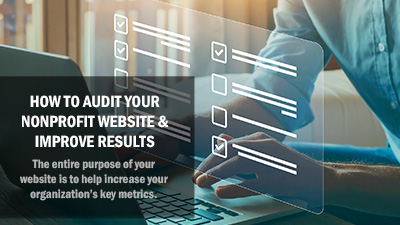How to Dramatically Improve Response to Your Nonprofit Website Content
 Creating a website takes a lot of effort. Although many nonprofit leaders tend to overly focus on the general aesthetics and homepage presentation, the other pages of the website oftentimes lack the same level of thought and effort. Don’t get me wrong, the homepage and design is important. However, if visitors to your website are not guided through the right process to get them to do what you want them to do, you’re missing tons of new relationships and potential supporters. Luckily, there is a simple formula that has helped marketing professionals to create compelling content that has been converting website visitors into relationships for a few decades now. That formula is called “AIDA.”
Creating a website takes a lot of effort. Although many nonprofit leaders tend to overly focus on the general aesthetics and homepage presentation, the other pages of the website oftentimes lack the same level of thought and effort. Don’t get me wrong, the homepage and design is important. However, if visitors to your website are not guided through the right process to get them to do what you want them to do, you’re missing tons of new relationships and potential supporters. Luckily, there is a simple formula that has helped marketing professionals to create compelling content that has been converting website visitors into relationships for a few decades now. That formula is called “AIDA.”
“A” is for Attention: Grab Them By The Eyeballs
Every great piece of advertising starts with a compelling headline and an image that reinforces that headline. Web pages are no different. Start with a clear impact statement that lets visitors know why they are on that page and why it’s important. The point here is to shift people from “I’m just browsing mode” (also known as “beta” mode) to “wait… this is for me” mode (also known as “alpha” mode).
Let’s take the following example from TruModel, a character development program that uses fashion to help young girls and women grow. The main headline for the page reads, “Looking for a Modeling School in Tampa?” It also uses a subheadline that reads, “TruModel trains girls and young women in the essentials of modeling and the fashion industry.” This is the attention-getting message the page wants to convey. Nothing else. If that message doesn’t appeal to you, then you aren’t the market TruModel is trying to engage with. But, if you are a person or have a daughter who is interested in modeling, the headline and subheadline are designed to capture your attention. The result is that this page and all the others on the website have an extremely low bounce rate and leads come in on a regular basis without much effort.
Think about what your audience is most interested in. They are the hero of the story, so you will want to think about the questions or statements that they would most identify with which most closely tie into the services you provide for your community. If speaking to donors, ask yourself why they give. If speaking to volunteers, ask yourself why they volunteer their time.

“I” is for Interest: Engage With Their Minds
The next step is about providing informative content that supports the question, statement, or claim of the headline. You want to take advantage of the fact that you have their attention to do a few things. First, identify with the issue you addressed in the headline. Explain how it makes sense and help them know that you understand how they are feeling. Explain how your organization, service, event, or program helps to address that issue and the role they play in that process.
For our TruModel example, we see that the first paragraph does a fantastic job at identifying and anticipating the concerns of their audience. Brainstorming the problems your “heroes” have is a critical step in creating interesting, engaging content. It makes your organization relevant in an instant and piques their curiosity to know more.
“D” is for Desire: Give Them What They Want
Once we have engaged our visitor with informative, relevant content, it’s time to create desire for whatever it is you are offering or speaking about. In the last paragraphs of the TruModel example, we see that they begin to draw a picture of the results of their program with descriptions of the kind of woman you could expect to become through their program. They also enumerate the values that you can expect to inherit. These values are universally desired and powerful when applied to the specific market they are targeting.
Think about what compels people to want what you have. Whether it’s altruistic pride in being a part of something bigger or experiencing the impact of what your organization does for others, there is an inherent value to the right people in becoming involved with your organization. Focus the third part of your content on those things and lead them into the final phase.
“A” is for Action: Tell Them What To Do
Now it’s time to put up or shut up. You’ve got their attention. You’ve engaged them with relevant information. You’ve compelled them by explaining what is in it for them. The juggling act is over – now it’s time for them to do something to get it all. This is the step that I find most commonly missed – asking people to do something very specific once they have been engaged. Sometimes, it’s as simple as adding a form on every page, like our TruModel example. Other times, you can add buttons or links to landing pages. If you are promoting an event, prompt them to “register now.” If you are offering a daily devotional, ask them to give you their e-mail address. Be intentional, direct and very specific.
Also, only tell them to do what is absolutely necessary, and only ask for minimum information necessary to allow you to connect with them. Once they’ve taken action, the relationship is yours and you can continue to grow what you know later. But at this moment, the idea is to get them to MOVE. Don’t be afraid to ask for something on every page. However, please do not always make this a monetary donation solicitation. Create a variety of ways and reasons for a person to engage with you. Again, once the connection is made, you can grow them into an army of committed supporters through regular communication and multiple opportunities to be involved.
Final Thoughts
Every page of your website should be evaluated by the “AIDA” formula. Ask yourself, “If a visitor only sees this one page and no other pages of my website, would they be compelled to act in some way?” Sometimes, it’s just about restructuring your content in a way that is organized. Other times, you just need some sort of a call to action. But, whatever you do, you must give every page the attention it deserves. If the page is unimportant and does not serve a purpose that can be helped by “AIDA,” remove it or combine the content with another page that does.
Bonus Action Point: Evaluate three of your current web pages using the “AIDA” formula and think about ways to improve them. For extra credit, write a new page for your website that uses “AIDA” from the beginning. I promise, you’ll see an instant improvement in the quality of what you write.

Need help to create killer content for your nonprofit website? Learn from The Killer Nonprofit Website Strategy.
Using Your Prescription to Attract Website Traffic
As a nonprofit organization, driving traffic to your website is crucial for increasing awareness, engagement, and support for your cause. A well-strategized approach to providing compelling information about the prescriptions you offer can significantly enhance your online presence.
How Nonprofits Can Increase Education About Their Causes
In the world of nonprofits, raising awareness and educating the public about the causes you champion is vital. Effective education not only informs but also inspires action and support. One of the most powerful tools at your disposal is your website. By driving traffic to your website, you can significantly boost your educational outreach. Here, we delve into the top strategies for increasing education about the problems and issues your nonprofit addresses.
How To Audit Your Nonprofit Website and Improve Results
If your nonprofit's website isn't contributing to your most important key metrics, there is a simple process you can go through to improve it. Using goals (not best practices), you can increase the reach, connections, and contributions your website drives month after month.



